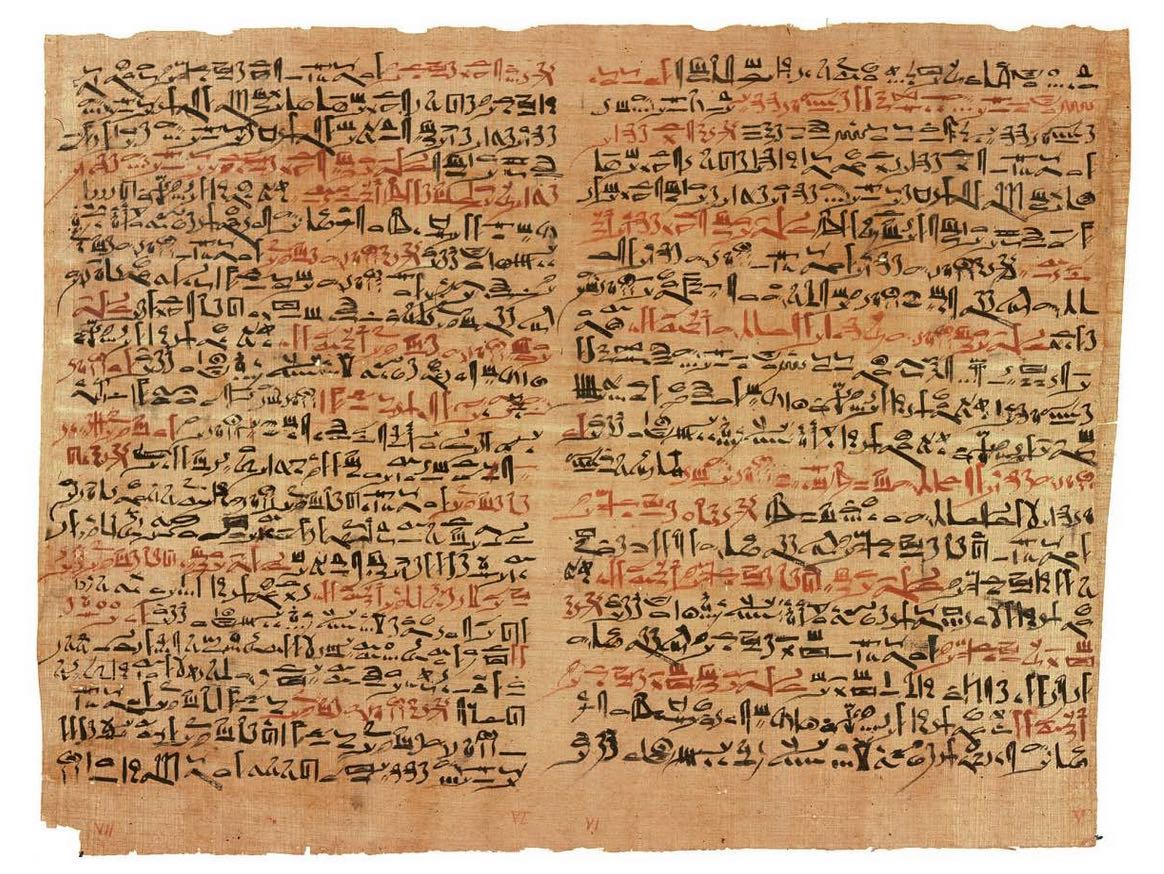
Plates vi & vii of the Edwin Smith Papyrus are housed at the Rare Book Room of The New York Academy of Medicine. Written in ancient Egyptian hieratic script, it was finally translated into English in 1930. Included in it are descriptions of procedures for closing wounds with sutures, preventing and curing infections with honey and moldy bread, stopping bleeding using raw meat, and patient immobilization for instances of head trauma and spinal cord injuries. Pictured above, is the section which discusses facial trauma injury. (Cases 12- 20).
The Edwin Smith Papyrus was a comprehensive medical text, on trauma surgery, from Ancient Egypt, written around 1500 BC. It was discovered in 1862 outside of Luxor, Egypt, and is named after the dealer who bought it in 1862. It is the oldest known surgical treatise on trauma injury, and the oldest known surgical text in the history of human civilisation.
The scroll itself is a copy of an earlier text dating from around 3,000 B.C. and describes the medical practice of the ancient Egyptians in the Nile River Basin during the earliest developments of human civilisation. It contains instructions, for physicians, regarding the diagnosis, treatment, and prognosis of injuries. Considering it was written 5,000 years ago, it was a remarkably revolutionary applied medical practice, in that it totally abandoned the usual means of healing, by magic and mysticism, to embrace diagnostic and treatment regimes that favoured observation, logic and deductive reasoning as standard practice.
The original text is a manual of techniques designed to be used in military injury treatment and related surgeries. It describes 48 cases of mostly trauma derived injuries, such as fractures, combat wounds, dislocations, even the treatment of certain tumours. Dating back to Dynasties 16–17 of the Second Intermediate Period in ancient Egypt, c.1600 BCE, this remarkable papyrus is unique among those principal medical papyri that are still in existence. Other ancient papyri (such as the Ebers Papyrus and the London Medical Papyrus) are medical texts describing practices of healing by means of magic and incantation, but the Edwin Smith Papyrus is unique and distinct, amongst such ancient documents, in that it presents a sound rational and scientific approach to medicine.
This was almost inconceivable for the time, considering the usual practices of very ancient civilizations like those of Egypt. This uniqueness seems to have been deemed acceptable, due to it being focused in those areas where medicine and magic did not obviously conflict. Healing magic would have been more applicable and mostly used in the cases of mysterious ailments, or what were then technically undiagnosable matters, such as internal diseases and other more biological infirmities. As a documentary record of history, the text reveals that a high level of sophistication and practical application was clearly extant in ancient Egyptian surgical medicine.
Egyptian civilisation fell into decline during the next historical era, and the teachings of this most valuable Papyrus were lost with the passage of time. The next great leap forward for medical science would not come until much later, when, in 300 B.C. the ancient Greek scholar, Hippocrates, once again brought logic to the fore in medical thinking, practice and teaching.
It seems that Hippocrates used his, now strongly presumed to be, knowledge of the contents of the Edwin Smith Papyrus as the basis for his own ideas and the subsequent advancement of our medical understanding and practice from his time onwards.
Another decline in medical practice and understanding, occurred in Europe’s Dark Ages. Healers once again resorted to spells, incantations and prayers instead of scientific judgment and reason. Hippocrates concepts were recognised by certain scholars, but they were not yet a functioning part of mainstream medical practice. Only during the Renaissance did medicine seriously begin to move away from its more non rational roots, which enabled Hippocratic teachings to become the foundation of modern medicine, including the Hippocratic Oath, as its ethical Credo.
In the 17th century the ancient Greek texts became the historical basis for many of the concepts that physicians and patients today take for granted as common practice. Even so, all of this scientific and medical progress originated with the ancient Edwin Smith Papyrus, and its remarkably advanced scientific method, thereby ensuring that it commands immense respect, as a seminal source of influence, knowledge and insight, regarding the historical origins of Medical Science and Practice.









